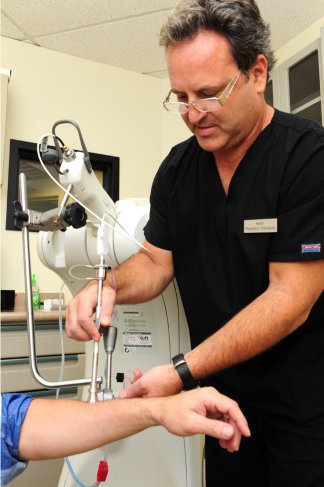Non-surgical Skin Cancer Option
Dr. Richard Levy
Director of radiation oncology at Hawaii Skin Cancer Center
Where did you receive your schooling and training?
I earned my M.D. at Boston University School of Medicine and my Ph.D. in biophysics at the University of California at Berkeley. I have held residencies in internal medicine at the Children’s Hospital of San Francisco (a UCSF affiliate, now named California Pacific Medical Center), and in radiation oncology at Loma Linda University Medical Center. I am board certified in internal medicine and radiation oncology.
mw-dih-hawaiiskincancercenter-nw3
What got you interested in the field of skin cancer?
While doing general radiation oncology work in 2012 at Yuma Oncology Center in Arizona, I was introduced to the Xoft Axxent Electronic Brachytherapy (eBx) System. I immediately was taken with the user-friendly Xoft System technology and with the clinical successes that I observed firsthand, leading me to pursue introducing and applying that same treatment technique at many other medical facilities, including dermatology practices in Arizona, California and now on Oahu.
What is the Xoft System and what kinds of cancer does it treat?
The Xoft System is an isotope-free radiation oncology treatment solution with significant treatment time and cost advantages for patients. It is FDA-cleared to treat a wide array of cancers including breast, vaginal, endometrial, cervical and nonmelanoma skin cancer (NMSC).
How does the system work and how is it better than traditional methods?
Using proprietary miniaturized X-ray technology, the system targets cancer while sparing healthy tissues, such as the heart, lungs and ribs. This treatment is painless, non-surgical and isotope-free, which means it is safe enough for physicians to stay in the room while the patient gets radiation treatment.
Although the primary method for removing NMSC is surgery, the Xoft treatment is a good non-surgical option for patients with lesions in cosmetically sensitive locations, such as the eyelid, nose, lips, ears, forehead, or patients with poor wound-healing, such as individuals with diabetes or who may require blood-thinning medications for cardiac reasons.
As a general rule, Xoft treatment offers good-to-excellent cosmetic results and relatively few problems with wound-healing. The Xoft System’s low energy X-ray source also minimizes damage to underlying cartilage, tendons or bones.
What is melanoma and why does the system only treat nonmelanoma skin cancer?
Melanomas are much more aggressive tumors, often deeply penetrating and extending to regional lymph nodes and beyond. Radiation treatment for melanoma requires technology that can deliver a uniform dose to much deeper levels below the skin surface and to cover much wider cross-sectional targets.
You mentioned the system can be used for gynecological cancers and breast cancer as well. Does that mean it works for skin cancers in those areas (on exposed and unexposed skin)?
The Xoft System is designed to work with a variety of applicators that can be used for the treatment of different cancers.
For the treatment of breast cancer, the Xoft System is used at the time of lumpectomy to radiate the cavity from where the lump was removed. This procedure is called intraoperative radiation therapy, or IORT, and uses a specific set of balloon-shaped applicators that also come in a variety of sizes to ensure a precise fit.
For gynecological use, the Xoft System may be used to treat endometrial or cervical cancers. A specialized set of applicators exists for this type of treatment as well.
How prevalent is NMSC, and how does Hawaii fare statistic-wise?
The best available data is an annual incidence in the US of about 3.5 million cases of nonmelanoma skin cancers. These data are not systematically reported into centralized data bases, so very precise state-specific data is not available.
However, it is very well-established that skin cancers are much more prevalent in geographic regions closer to the equator, where the UV rays of the sun are more directly overhead, and thereby less filtered by the intervening atmosphere, and in locations where people spend more time outdoors and with more skin exposed to the sun, like Hawaii, where outdoor and beach activities are so prevalent. It’s also the case that fair-skinned people (with lesser melanin content in the skin) are dramatically more susceptible to developing skin cancers than darker-skinned people.
Anything else you’d like to mention?
To date, more than 10,000 patients have been treated globally, across all clinical applications, with the Xoft System. It is the only FDA-cleared electronic brachytherapy system that has been used to treat more than 7,000 NMSC patients and is supported by positive three-year clinical data.
Studies also show that the Xoft System yields excellent cosmetic results of NMSC lesions.
I am excited to bring this innovative treatment option to NMSC patients in Oahu.






